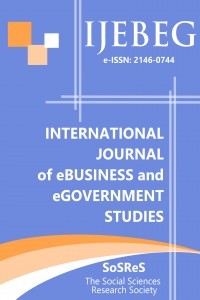OCCUPATIONAL HEALTH AND WORK SAFETY SYSTEMS IN COMPLIANCE WITH INDUSTRY 4.0: RESEARCH DIRECTIONS
OCCUPATIONAL HEALTH AND WORK SAFETY SYSTEMS IN COMPLIANCE WITH INDUSTRY 4.0: RESEARCH DIRECTIONS
Industry 4.0 is the contemporary approach that denotes the transformation process in the global chains of value creation. This approach has a potential to remove restrictions between physical objects, converting them into a comprehensive complex system of interoperable, interconnected and interdependent components. Given Industry 4.0 becoming the eminent concept, occupational health and safety management (OHSM) systems have been facing new challenges. On the other hand, to the best of our knowledge, we argue that current state of the art does not sufficiently take account of whether the “Fourth Industrial Revolution” will impact occupational health and safety in industry 4.0-based supply chains. The main goal of this research, therefore, is to demonstrate several new research opportunities that may advance our knowledge of Industry 4.0 based OHSM. In this regard, the contribution of this study is twofold: first, it investigates the current literature studying how Industry 4.0 may affect OHSM activities in contemporary supply chains and organizations. Secondly, given the analysis of the current state of the art, future research directions and proposals are discussed.
Keywords:
Industry 4.0, Occupational Health and Work Safety, Literature Review Research Opportunities,
___
- Alekseev A. N., Buraeva E. V., Kletskova, E. V., and Rykhtikova, N. A. (2019). “Stages of Formation of Industry 4.0 and the Key Indicators of Its Development”, (In: Elena G. Popkova, Yulia V. Ragulina, Aleksei V. Bogoviz-Ed., Industry 4.0: Industrial Revolution of the 21st Century), Springer, 2019.
- Badri, A., Boudreau-Trudelc, B. and Saâdeddine Souissid, A. (2018). “Occupational health and safety in the industry 4.0 era: A cause for major concern”, Safety Science 109, 403–411.
- Bagheri B, Yang S, Kao H, Lee J (2015). “Cyber-physical systems architecture for self-aware machines in Industry 4.0 environment”, IFAC-Pap Online, 48–3,1622–1627.
- Bartodziej, C. J. (2017). The Concept Industry 4.0 An Empirical Analysis of Technologies and Applications in Production Logistics, Springer Gabler, Germany.
- Beetz, M., Bartels, G., AlbuSchaffer, A., BalintBenczedi, F., Belder, R., Bebler, D., Haddadin, S., Maldonado, A., Mansfeld, N., Wiedemeyer, T., Weitschat, R., Worch, J. H., (2015). “Robotic agents capable of natural and safe physical interaction with human co-workers”, In: IEEE International Conference on Intelligent Robots and Systems, art. no. 7354310, 6528–35.
- Berman, B. (2012). “3-D printing: the new industrial revolution”, Business Horizons, 55, 2, 155-162.
- Fernández, F.B., Pérez, M.Á.S., (2015). “Analysis and modeling of new and emerging occupational risks in the context of advanced manufacturing processes”, Procedia Eng. 100, 1150–1159.
- Giusto, D., A. Iera, Morabito, G. and Atzori, L. (2010). The Internet of Things, Preface. 20th Tyrrhenian Workshop on Digital Communications.
- Granerud R.L. and Rocha R.S. (2011). “Organisational learning and continuous improvement of health and safety in certified manufacturers”, Safety Science, 49, 1030-9.
- GTAI (2015), Industry 4.0: Smart Manufacturing For the Future, https://www.manufacturing-policy.eng.cam.ac.uk/documents-folder/policies/germany-industrie-4-0-smart-manufacturing-for-the-future-gtai/view, [accessed 02.04.2019]
- Hakkinen, K. (2014). “Safety Management: From Basic Understanding Towards Excellence” (In: Seppo Väyrynen, Kari Häkkinen, Toivo Niskanen- Ed., Integrated Occupational Safety and Health Management, Springer.
- Kagermann H., Wahlster W. and Helbig J. (2013). “Recommendations for implementing the strategic initiative INDUSTRIE 4.0”. Heilmeyer und Sernau, Germany.
- Kamble, S. S., Gunasekaran, A. and Gawankar, S.A. (2018). “Sustainable Industry 4.0 framework: A systematic literature review identifying the current trends and future perspectives”, Process Safety and Environmental Protection, 117, 408–425.
- Kumar, S. P. L. (2017). “State of The Art-Intense Review on Artificial Intelligence Systems Application in Process Planning and Manufacturing”, Engineering Applications of Artificial Intelligence, 65, 294–329.
- Mellor, S., Hao, L. and Zhang, D. (2014). “Additive manufacturing: a framework for implementation”, International Journal of Production Economics, 149,194-201.
- Minturn, A. (2017), http://www.controlengeurope.com/article/133867/Safety-first--How-Industry-4-0-can-optimise-safety.aspx, [Accessed 20.09. 2018].
- Queiroz, M. M., Telles, R. and Bonilla, S. H. (2019). “Blockchain and supply chain management integration: a systematic review of the literature", Supply Chain Management: An International Journal, https://doi.org/10.1108/SCM-03-2018-0143.
- Pei, F.Q., Tong, Y.F., He, F., Li, D.B., (2017). “Research on design of the smart factory forforging enterprise in the Industry 4.0 environment”, Mechanika, 23,1, http://dx.doi.org/10.5755/j01.mech.23.1.13662.
- Reinert, D. (2016). “The future of OSH: a wealth of chances and risks”, Industrial Health, 54 (5), 387–388.
- Rose, K., Eldridge, S. and Chapin L. (2015), The internet of things: an overview, Internet Society, https://pdfs.semanticscholar.org/df53/501af80026c4379a3467b551caaf7589a1db.pdf?_ga=2.249674694.1579334769.1554303857-1689866690.1554303857 [Accessed 03.04. 2019]
- Salkin, C., Oner, M., Ustundag, A., and Cevikcam, E. (2018). “A Conceptual Framework for Industry 4.0” (In: Alp Ustundag, Emre Cevikcan -Ed., Industry 4.0: Managing The Digital Transformation), 3-23 Springer, UK.
- Veza, I., Mladineo, M., and Gjeldum, N., (2015). “Managing Innovative Production Network of Smart Factories”, IFAC-PapersOnLine, 48-3, 555–560.
- Wang L, Wang G (2016). “Big data in cyber-physical systems, digital manufacturing and Industry 4.0”, International Journal of Engineering Manufacturing, 4, 1–8.
- Witkowski, K. (2017). “Internet of Things, Big Data, Industry 4.0: Innovative Solutions in Logistics and Supply Chains Management”, 7th International Conference on Engineering, Project, and Production Management, Procedia Engineering, 182, 763 – 769.
- Başlangıç: 2009
- Yayıncı: Sosyal Bilimler Araştırmaları Derneği
Sayıdaki Diğer Makaleler
AGRICULTURAL PRODUCTION IN SOUTH AFRICA: INFORMATION AND COMMUNICATION TECHNOLOGY (ICT) SPILLOVER
Oladipo Olalekan DAVİD, Wynand GROBLER
E-COMMERCE IN TURKEY AND SAP INTEGRATED E-COMMERCE SYSTEM
Abdirashid Ali ADLE, Ömür AKDEMİR
OCCUPATIONAL HEALTH AND WORK SAFETY SYSTEMS IN COMPLIANCE WITH INDUSTRY 4.0: RESEARCH DIRECTIONS
A COMPARATIVE ANALYSIS OF E-GOVERNMENT SERVICES OF CROTIA, POLAND AND TURKEY
Zafer KILIÇ, Vildan ATEŞ, Aleksandar ERCEG, Sebastian JABLONSKI
AN INVESTIGATION INTO SUSTAINABLE SUPPLY CHAIN MANAGEMENT PRACTICES IN A DEVELOPING COUNTRY
İsmail Erol, Meltem NURTANIŞ VELİOĞLU
Daniel Francois MEYER, Thomas HABANABAKİZE
WEBSITE USAGE IN DIGITAL PUBLIC RELATIONS – AN ANALYSIS OF IT COMPANIES IN TURKEY
